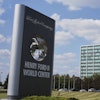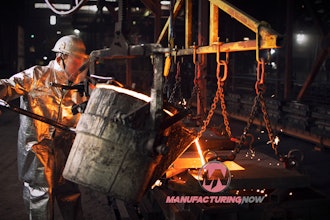Food irradiation has yet to enjoy broad commercial adoption; but as the food industry struggles with food safety issues, the timing finally seems right.
In the summer of 1961, a nondescript truck rolled through Canada and the United States making frequent stops to show off a new technology that would benefit potato farmers, meat packers and fruit and vegetable growers. More than 40 years later, this same technology stands poised to significantly improve the safety, quality and variety of both the domestic and international food supply.
The mobile irradiator of the 1960s, originally built for the purpose of sprout inhibition in potatoes, has been replaced by large-scale irradiation facilities designed primarily for the sterilization of single-use medical devices. Despite the lack of widespread adoption of irradiation within the food industry, some 175 million tons of spices and 15-18 million pounds of ground beef and poultry are irradiated annually in the U.S. alone. In 2007, for the first time in 20 years, shipments of mangos from India began to arrive in the U.S. These shipments were made possible through the use of irradiation, which is the only United States Department of Agriculture (USDA) approved treatment for the export of this fruit.
The time is now
Although food irradiation has been in use for the past four decades, it has yet to enjoy broad commercial adoption due to a combination of regulatory, consumer acceptance and industry issues. However, experts in the industry believe there is compelling evidence to show that the time is now right for food irradiation.
In 2007 alone, more than 34 million pounds of ground beef were recalled in the U.S. as a result of contamination with E. coli - the highest amount since 2002. Cases of E. coli in leafy greens have garnered increased attention in recent months, with many food safety experts - such as Dr. Dennis Olson of Iowa State University - touting irradiation as the only viable final microbial kill step for these products. Also, the U.S. has signed bilateral trade agreements with eight countries in the past two years allowing the use of irradiation for phytosanitary treatment of fruits and vegetables being exported to the United States.
Understanding the process
The process for irradiating food is fundamentally simple: boxes or pallets of product are exposed to radiation from a Cobalt-60 source, electron beam or x-ray. The amount of radiation prescribed depends on the desired effect. The lowest doses are used to delay ripening, inhibit sprouting and extend shelf life by reducing spoilage organisms. Slightly higher doses render insects sterile or non-viable, to avoid infestation of crops in the country where the product is being exported. Medium doses effectively eliminate life-threatening pathogens such as E. coli, Listeria and Salmonella, substantially improving the safety of the food. In an interesting, but less mainstream application of the technology, the highest doses are used to sterilize food for consumption by astronauts, making it shelf stable without the need for refrigeration. All of the dose levels used for food irradiation have been proven safe and effective through decades of research, and the process is endorsed by agencies such as the World Health Organization and U.S. Food and Drug Administration (FDA).
Food irradiation is performed almost exclusively by companies that provide contract sterilization services, such as Food Technology Service Inc. (www.foodtechservice.com), located in Mulberry, Florida. FTSI's facility is specially equipped with refrigerated warehousing and meets the same FDA standards as any other food processing facility. Constructed in 1991 for the treatment of citrus fruit, FTSI has seen many different applications of the technology, including shelf life extension of strawberries and disinfestation of fruit for interstate shipment. Currently, most of its food irradiation business is focused on ensuring food safety in frozen ground beef patties. Companies like FTSI work closely with the food industry to develop protocols for the overall efficacy of the irradiation process and quality of the food.
Recent legislation in the U.S. that approves irradiation as a quarantine treatment for certain fruits being exported by certain countries has given rise to a new industry for contract irradiation. BENEBION (www.benebion.com) of Guadalajara, Mexico, is currently building a facility that will treat several types of tropical fruits for export to the U.S. This replaces the use of methyl bromide (an ozone-depleting substance being phased out globally under the Montreal Protocol) and hot water dip processes with a more environmentally friendly technology that ultimately yields a superior product at a comparable cost. The first market test of the technology for quarantine treatment under the new legislation occurred in 2007 when 160 tonnes (approximately 352,740 lbs) of mangos from India arrived in the U.S. and were snapped up by consumers who previously were unable to purchase this particular variety in American stores. Subsequently, food producers in Thailand have also shipped irradiated fruits such as mangosteen and longan into the U.S. market, and in 2008 Indian mango exports are expected to grow to over four million pounds.
Current research
Research in food irradiation continues to advance both the science behind the technology and its commercial application. The Agriculture Research Service of the USDA has conducted numerous studies on establishing effective radiation doses for reducing pathogens in many different foods, including leafy greens such as spinach. The Minnesota Beef Council (www.mnbeef.org) and University of California at Davis (www.ucdavis.edu) both study consumer acceptance of irradiated food. At the most recent International Meeting on Radiation Processing (IMRP), held in Kuala Lumpur, Malaysia in 2006, food irradiation garnered significant positive attention, as it will again at the next IMRP scheduled for September 2008 in London, England (www.imrp2008.com).
Organizations such as the International Irradiation Association (www.doubleia.org) and Food Irradiation Processing Alliance (www.fipa.us) in the U.S. continue to advance food irradiation by providing education and awareness. They also play a key role in helping the industry tackle related commercial and regulatory issues, such as the recently proposed rule from the FDA on the subject of reduced requirements for labeling irradiated food, and the petition currently before the FDA to allow irradiation of Ready To Eat (RTE) products, specifically fresh cut fruits and vegetables.
For food producers and consumers, the benefits seem clear: safer food, better quality product and greater variety, all made possible for pennies a pound. So why hasn't the industry embraced this technology with more enthusiasm? This is the question we should be asking as we scrutinize the food supply and look for ways to improve its safety in the wake of recent recalls and increased concern about the globalization of supply. Increasing consumer pressure, better understanding of the technology by the food industry and widespread use in the international marketplace will all help to drive adoption and build a critical mass of support for food irradiation.
For more information about irradiation, visit www.mdsnordion.com


















